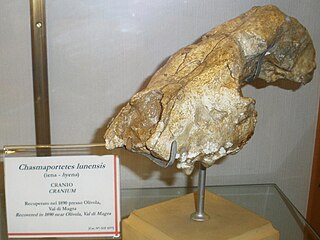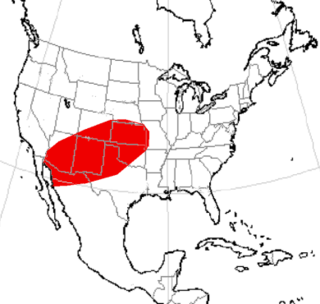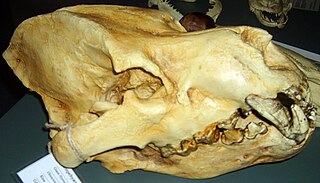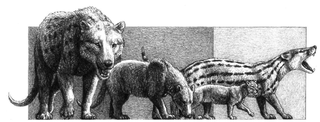
Hyenas, or hyaenas, are feliform carnivoran mammals belonging to the family Hyaenidae. With just four extant species, it is the fifth-smallest family in the Carnivora and one of the smallest in the class Mammalia. Despite their low diversity, hyenas are unique and vital components of most African ecosystems.

Pseudaelurus is a prehistoric cat that lived in Europe, Asia and North America in the Miocene between approximately twenty and eight million years ago. It is considered to be a paraphyletic grade ancestral to living felines and pantherines as well as the extinct machairodonts (saber-tooths), and is a successor to Proailurus. It originated from Eurasia and was the first cat to reach North America, when it entered the continent at about 18.5 Ma ending a 'cat-gap' of 7 million years. The slender proportions of the animal, together with its short, viverrid-like legs, suggest that it may have been an agile climber of trees.

Hyaenodon ("hyena-tooth") is an extinct genus of carnivorous placental mammals from extinct tribe Hyaenodontini within extinct subfamily Hyaenodontinae, that lived in Eurasia and North America from the middle Eocene, throughout the Oligocene, to the early Miocene.

Pachycrocuta is an extinct genus of prehistoric hyenas. The largest and most well-researched species is Pachycrocuta brevirostris, colloquially known as the giant short-faced hyena as it stood about 90–100 cm (35–39 in) at the shoulder and it is estimated to have averaged 110 kg (240 lb) in weight, approaching the size of a lioness, making it the largest known hyena. Pachycrocuta first appeared during the late Miocene. By 800,000 years ago, it became locally extinct in Europe, with it surviving in East Asia until at least 500,000 years ago, and possibly later elsewhere in Asia.

Chasmaporthetes, also known as hunting or running hyena, is an extinct genus of hyenas distributed in Eurasia, North America, and Africa during the Pliocene-Pleistocene epochs, living from 4.9 million to 780,000 years ago, existing for about 4.12 million years. The genus probably arose from Eurasian Miocene hyenas such as Thalassictis or Lycyaena, with C. borissiaki being the oldest known representative. The species C. ossifragus was the only hyena to cross the Bering land bridge into the Americas, and ranged over what is now Arizona and Mexico during Blancan and early Irvingtonian Land Mammal ages, between 5.0 and 1.5 million years ago.

Adelphailurus is an extinct genus of metailurin machairodontine (saber-toothed) cat that inhabited western North America during the middle Pliocene. It is monotypic, containing only the species Adelphailurus kansensis.

Amphicyon is an extinct genus of large carnivorans belonging to the family Amphicyonidae, subfamily Amphicyoninae, from the Miocene epoch. Members of this family received their vernacular name for possessing bear-like and dog-like features. They ranged over North America, Europe, Asia, and Africa.

Percrocuta is an extinct genus of hyena-like feliform carnivores. It lived in Europe, Asia, and Africa, during the Miocene epoch.

Feliformia is a suborder within the order Carnivora consisting of "cat-like" carnivorans, including cats, hyenas, mongooses, viverrids, and related taxa. Feliformia stands in contrast to the other suborder of Carnivora, Caniformia.

Herpestes is a genus within the mongoose family Herpestidae. Several species in the family are known as slender mongooses. It is the type genus of the family, and comprises 5-6 living species, each with several subspecies. Fossil remains of three prehistoric species were excavated in France, and described in 1853.

Percrocutidae is an extinct family of hyena-like feliform carnivores endemic to Asia, Africa, and Southern Europe from the Middle Miocene through the Pliocene, existing for about 8 million years.
Miomachairodus is an extinct genus of large machairodontine containing only a single species, Miomachairodus pseudailuroides. It is known from Miocene-age fossils in China and Turkey and persisted until the Late Miocene. Fossils of this machairodont have been found in the Vallesian-age Bahe Formation in Shaanxi, China, and Yeni Eskihisar in Anatolia. This Turkish site is of Miocene age and is well known for its pollen studies.
Gobicyon is an extinct genus of large-sized carnivoran mammals, belonging to the Amphicyonidae, that was discovered in China, Mongolia, and Serbia, and lived during the Middle Miocene epoch. Despite only being known from rather fragmentary remains, recent discoveries showcase that it was an aberrant member of the subfamily Haplocyoninae, with adaptions towards bone-crushing similar to those of a hyaena.

Lartetotherium is an extinct genus of rhinoceros that lived during the Miocene in Europe and possibly China.

Promegantereon is an extinct genus of machairodont from the Miocene of Europe. It is one of the oldest machairodont cat species in the Smilodontini and is believed to be an ancestor of Megantereon and Smilodon.
Styriofelis is an extinct genus of Felidae known from the Miocene of Europe.
Miopanthera is an extinct genus of Pseudaelurus-grade felids.
Lophocyonidae is an extinct family of feliform carnivorans from the Miocene of Europe.
Sivanasua is an extinct genus of carnivorous mammal found across Miocene Europe including Germany, Austria, France, Spain and the Czech Republic. Like other lophocyonids, Sivanasua had unusual lophodont dentition, meaning the molars had ridges across the grinding surface of the molars, an adaptation believed to be indicative of a herbivorous diet.

Afrosmilus is a fossil genus of afrosmilin barbourofelid. It vived in Africa during the middle Miocene.














